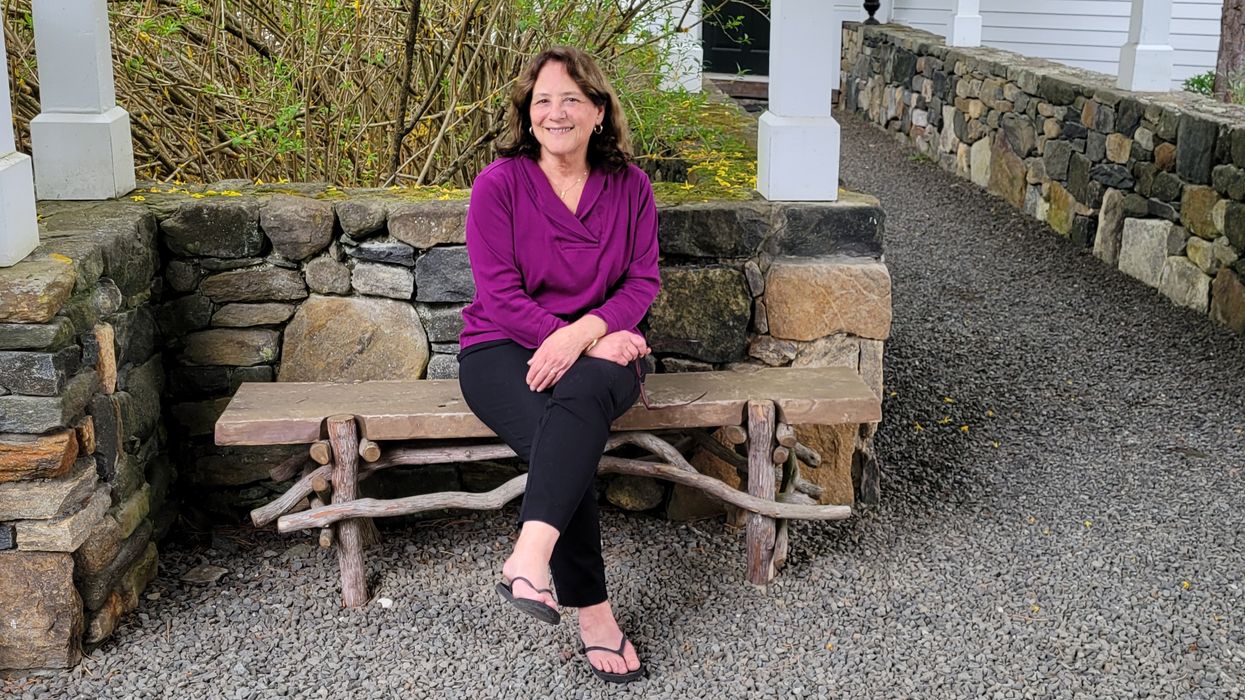Housatonic Valley’s ‘Conservation Hero’ leaves lasting legacy

Lynn Werner, executive director of the Housatonic Valley Association, has been a driving force in land and water conservation for more than 40 years.
Debra A. Aleksinas

Lynn Werner, executive director of the Housatonic Valley Association, has been a driving force in land and water conservation for more than 40 years.
“Her heart is always with the water, and yet under her leadership, HVA became more than a watershed organization but also an accredited land trust.” —Tim Abbott, conservation director, Housatonic Valley Association
CORNWALL — Lynn Werner was smitten by the smelts.
Fresh out of college, she landed a job as a researcher with the state fisheries division counting young salmon.
“It was a phenomenal job. We would set up traps mid-stream and count the smelts in there and then release them. I would hang onto the rocks and just be one with the water,” as the small, silvery fish sparkled and splashed around her.
“I could have done that forever,” she recalled.
Fortunately for the Cornwall-based Housatonic Valley Association, which she joined in 1982, Werner soon found herself advocating for the streams, rivers, wetlands and forests that had been such an integral part of her youth.
“I benefitted from the Clean Water Act. If I had to sit next to a river or lake and not be able to swim in it, that would be my idea of torture,” said Werner, 67, who has been a staunch advocate in land and water conservation for more than four decades.
Since she became executive director in 1995, HVA has expanded its staff from five to 17, quadrupled its budget and launched transformative conservation initiatives.
Earlier this year, Werner announced her plan to retire from her role at HVA effective June 30.
“We just finished our strategic plan, and I felt it was a good time,” she explained recently over a cup of coffee at the Warren General Store, a short distance from her Kent home.
“I started discussing it in earnest in 2023, going into 2024 with several board members,” Werner explained. A search committee has selected her yet unnamed successor and plans to make the announcement later this month.
In the meantime, Werner said she will be assisting with the transition.
Long list of accomplishments
As executive director, Werner oversees the day-to-day management of the association including collaborating with individuals, groups and agencies with the goal of maintaining a healthy river system.
The association recently received an accreditation renewal from the Land Trust Accreditation Commission for a third five-year term.
Werner’s list of accomplishments includes the restoration of Furnace Brook Fishway in Cornwall that allowed trout to swim upstream to spawn for the first time in 20 years. She also was instrumental in ensuring that General Electric and the federal Environmental Protection Agency (EPA) clean up the PCBs in the watershed system and created the River Smart campaign to study the impact of polluted runoff and how to reduce it.
HVA, under Werner’s leadership, successfully fought to reroute a natural gas pipeline away from protected lands and wetlands, stopped a superhighway route through the scenic river ridgeline and saved 6,000 acres of river valley from developers.
She credited collaboration, both within HVA and in the communities, as the key to her success. “You can only be as great as the team you’re working with, and we’ve also been fortunate to collaborate with so many wonderful partners. There is a really strong network of both nonprofits and community leaders working to protect this tristate river valley, and this gives me hope for the future.”
The association also launched the “Follow the Forest” initiative to protect a connected woodland wildlife corridor and conducted educational programs for kindergarten to high school students on biology, ecology and chemistry of the watershed.
“Protecting the core forest corridor throughout the Housatonic River watershed makes climate resiliency sense. And this region is part of a much larger corridor stretching into Canada,” she explained.
Werner stressed the importance of getting kids with “nature deficit disorder” involved in the environment, as they are the environmental leaders of the future.
What you love, you protect, said Warner, who early on in her career co-chaired and helped form the Clean Water Coalition and served on the legislature’s Aquifer Protection Task Force.“And most kids seem to love a good splash in a stream, and especially a nose-to-nose moment with a frog, it’s a joy to behold.”
Werner felt that defending nature begins in the place where you live.
“A lot of people don’t know how much power they have,” she noted. “Take a stand where you are, small or big. Join the fight to protect that river or woodland or meadow or view that you love. And everyone can do one important thing in their own backyard or neighborhood to keep a stream healthy and a fish friendly, or feed and shelter butterflies and birds, or let rain replenish groundwater and wetlands. If you’re not sure where to start, just ask your favorite conservation group.”
Rivers, by their gentle beauty, are always moving, they’re always singing and the sound that they make is always soothing, reflected Werner.
“That river can’t fight for itself. It gives so much when you think about all that beauty, all that spiritual replenishment, all that life. We’re its voice and sometimes we have to fight for it.”
Lauded as ‘Conservation Hero’
In late March, the Connecticut Land Conservation Council (CLCC) honored Werner with its coveted Conservation Hero Award for her legacy of transformative leadership in the Housatonic Valley.
The council cited her role as co-founder of the Litchfield Hills Greenprint, her success with preserving more than 15,000 acres through the Stanley Works project, riverfront greenways and recent woodland corridor conservation.
Werner’s advocacy, according to the CLCC, has shaped public policy, strengthened stream flow protections, wetland conservation and strategic land preservation.
“She was instrumental in securing a settlement from General Electric for PCB contamination clean-up and helped achieve the 2022 Wild & Scenic designation for forty-one miles of the Housatonic River.”
HVA President Tony Zunino lauded Werner’s 40-year tenure with the organization earlier this year during its Annual Auction for the Environment. “Lynn’s leadership and vision has made an indelible mark on the Housatonic Valley Association,” he said in announcing her intent to retire.
Tim Abbott, conservation director at HVA, said her passion stems from her start back in the early 1980’s as a fisheries researcher with the state.
“She still looks back with evident joy and pride on the time she got to spend in rivers and streams counting salmon smelts. Her heart is always with the water, and yet under her leadership, HVA became more than a watershed organization but also an accredited land trust.”
Reflecting on Werner’s leadership style, Abbott noted: “HVA’s core conservation approach — collaborative, solution-oriented, grounded in science and the conviction that strong partners can do far more together than any of us can do alone — are Lynn’s greatest gift and legacy.”
Werner credited her entire team at HVA for their motivation, knowledge and talent. “It’s an honor, a joy, to work every day with such skilled and passionate people.”
In her retirement, Werner said she is looking forward to spending more time with her husband, seeing her grandchildren more, learning new cooking styles and staying connected to environmental causes.
She currently serves as president of the Rivers Alliance of Connecticut, is on the board of the Connecticut Legislative Conservation Voters and the Steep Rock Association.
“I am looking to stay in the game in a different way and be able to provide hands-on help in a way I haven’t been able to. It’s been an incredible journey and I have been incredibly fortunate.”
The Salisbury Winter Sports Association (SWSA) will host its annual Junior Jump Camp, a two-day introduction to ski jumping, on Saturday and Sunday, Dec. 27 and 28, from 9 a.m. to 2 p.m. at Satre Hill in Salisbury.
The camp is open to children ages 7 and up and focuses on teaching the basics of ski jumping, with an emphasis on safety, balance and control, using SWSA’s smallest hill. No prior experience is required.
The cost is $50 per child and includes instruction and lunch on both days. For more information or to register, visit www.skireg.com/swsa-camp or email info@jumpfest.org
Jesse Bunce, first selectman of North Canaan.
LITCHFIELD — The Northwest Hills Council of Governments welcomed six newly elected municipal leaders Thursday, Dec. 11, at its first meeting following the 2025 municipal elections.
The council — a regional planning body representing 21 towns in northwest Connecticut — coordinates transportation, emergency planning, housing, economic development and other shared municipal services.
Barkhamsted First Selectman Meaghan Cook, Goshen First Selectman Seth Breakell, Kent First Selectman Eric Epstein, Norfolk First Selectman Henry Tirrell, North Canaan First Selectman Jesse Bunce and Torrington Mayor Molly Spino were each elected to their post in November.
They filled the seats of their predecessors on the COG, who were each given a toast of appreciation: Nick Lukiwsky (Barkhamsted), Todd Carusillo (Goshen), Marty Lindenmeyer (Kent), Matt Riiska (Norfolk), Brian Ohler (North Canaan) and Elinor Carbone (Torrington).
COG Executive Director Rob Phillips said the outgoing members were given a going away mug that read “You’re living the dream still.” Members voted to appoint Warren First Selectman Greg LaCava to fill a vacancy on the Council’s Executive Committee. COG members voted by paper ballot, and LaCava defeated Burlington First Selectman Doug Thompson for the vacant seat.
Ryan Segalla takes a fadeaway shot over a defender.
FALLS VILLAGE — Housatonic Valley Regional High School’s boys basketball team defeated Pine Plains High School 60-22 in a scrimmage Tuesday, Dec. 9. The non-league preseason game gave both sides an opportunity to run the court ahead of the 2025-26 varsity season.
HVRHS’s senior-heavy roster played with power and poise. The boys pulled ahead early and kept their foot on the gas through to the end.
By halftime the score was 33-8. Junior varsity players subbed in for the second half, but not before the starters got some in-game dunk practice. By the end Housatonic totaled 60 points to Pine Plains’ 22.

Nick Crodelle led the Mountaineers offensively with 13 points. Anthony Labbadia and Wyatt Bayer scored nine points each. Anthony Foley scored eight points. Owen Riemer and Ryan Segalla each scored seven points. Peyton Bushnell hit a three-pointer. Jaxon Visockis and Henry Berry each scored two points.
HVRHS begins Berkshire League competition on the road at Nonnewaug High School Tuesday, Dec. 16, with a 6 p.m. tip off.


Katie Moore delivers toys to the Stuff a Truck campaign held by the Kent Volunteer Fire Department last weekend. Donated toys are collected so that parents, who need some assistance, may provide their children with gifts this Christmas. Accepting the donation are elves Fran Goodsell and Karen Iannucci
KENT — Santa’s elves were toasty warm as they collected toys for the children of Kent.
Keeping with annual tradition, Fran Goodsell and Karen Iannucci manned the Stuff a Truck campaign sponsored by the Kent Volunteer Fire Department on Saturday, Dec. 6, and Sunday, Dec. 7. Sitting in front of a fire pit in the firehouse parking lot between donations from residents, they spoke of the incredible generosity displayed every season. That spirit of giving was clear from the piles of toys heaped on a table.
“This is always so gratifying,” said Goodsell, noting that certain businesses, including High Watch Recovery Center, Wilson’s, and Kent and South Kent schools needed a “shout out” for all they’ve done. She said South Kent School focuses on gifts for older children, which is a group that often is overlooked.
Unwrapped contributions are sought for children 1 to 15 years old who might otherwise find little or nothing from Santa, they said. The bounty will be set up at the Community House on Thursday, allowing parents to come and take what they want. If there are still items left, grandparents are invited to “shop.”
The atmosphere was festive Saturday, as a stuffed dog began barking a Christmas tune whenever someone walked in front of it. A large decked-out bear posted at the parking lot entrance reminded passersby of the event. Visiting children were able to get a close-up look at the fire truck and walk through the firehouse if they wished.
Goodsell and Iannucci were very grateful to those who donated wood for the fire pit. “And so many asked if they could bring us coffee or hot chocolate,” said Iannucci.
Goodsell said many who came talked about having grown children who were recipients of the gifts when their families were struggling. “They are so glad to be able to give back,” she said.